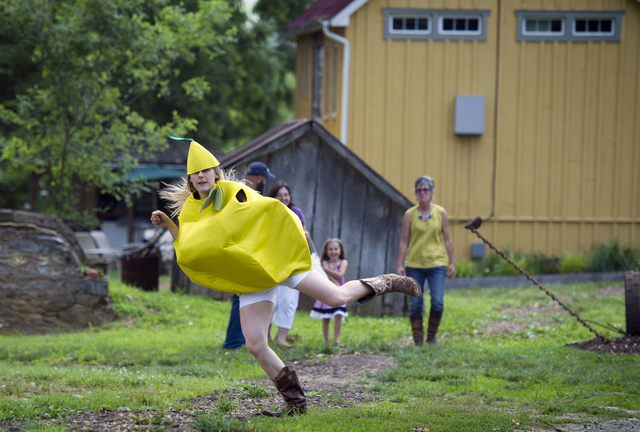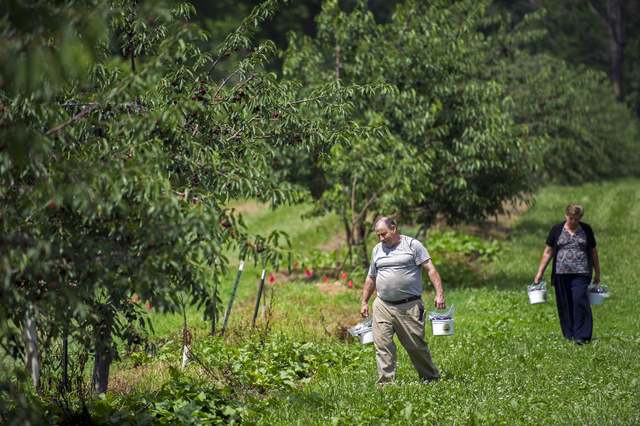Agriculture tourism helping to revive rural economies





CHARLES TOWN, W.Va. — With its sweet fruit-flavored liqueurs, a working farm and eccentric cast of characters— including a dancing lemon — Bloomery Plantation Distillery has attracted tourists from every U.S. state and countries as far away as Laos and Iceland.
The West Virginia mini-distillery is part of a growing agriculture tourism trend that advocates say can help revive struggling rural economies. Ag tourism refers to working farm enterprises geared to visitors, encompassing farm stands, pumpkin patches, barn dances, zip-line rides, pick-your-own berries, corn mazes and even weddings.
Farms engaging in ag tourism generated roughly $700 million in 2012 — a 24 percent increase over five years, according to the most recent U.S. Agriculture Department statistics. But that’s still a sliver compared to some other, more traditional forms of tourism; for example, visitors to national parks spent about $14.6 billion in communities within 60 miles last year.
Ag tourism is one of agriculture’s fasting growing sectors, said Kelly Smith, marketing and commodities director at the Missouri Farm Bureau. The bureau and the state Department of Agriculture recently hosted an ag tourism conference in Kansas City, where there was particular interest in weddings on farms and farm-to-table dinners, where food grown by a farmer is served at a meal on the farmer’s property.
“Many farmers are looking to add revenue streams to their farms,” Smith said.
Last month, the Appalachian Regional Commission, a federal agency charged with promoting economic development in that area, launched a map and guide of nearly 300 farmers markets, vineyards, farm-to-fork restaurants and other destinations in an effort to boost the industry. The map and guide were published in Food Traveler Magazine and online.
“Local food systems are growing throughout Appalachia, and their growth is making important economic contributions in rural communities,” said Earl F. Gohl, who co-chairs the commission along with West Virginia Gov. Earl Ray Tomblin.
Linda Losey, who had never owned a farm before, started Bloomery Plantation Distillery in 2011 after deciding to try her hand at making limoncello, an Italian lemon liqueur. The distillery uses many of its home-grown products in its drinks — “Moonshine Milkshake” and hard lemonade among them — plucking fresh raspberries, pumpkin, lemons and ginger.
Now, the business generates nearly $1 million in annual sales and employs 14 people. Until about a year ago, 97 percent of its business was selling onsite, but that’s changing, said Rob Losey, Linda’s ex-husband and business partner. The split is now 80-20, and Losey said that number will continue to shift.
“We’ll max out here. All the growth will be in external markets,” he said.
Employee Allison Manderino, 28, served up drinks at the small bar in a restored log cabin dating back to the 1800s. “I will be the poison police for you,” Manderino told a pair of customers before pouring herself a sample. After taking a swig, she confirmed, “Not poison.” Later, Manderino donned a lemon costume and danced with a customer.
Megan Bean, who recently visited the distillery from nearby Harpers Ferry, said West Virginia needs to promote tourism as much as possible.
“Especially with the locavore movement, slow food seems to be getting bigger and bigger all the time,” she said “If we can be a part of that, it’s a great thing.”
About 16 miles away in Martinsburg, West Virginia, family farm George S. Orr & Sons added a retail market in 1995. Retail sales now generate about 15 percent of the business, up from 5 percent just seven years ago, said retail market manager Katy Orr-Dove. The rest is mostly wholesale fruit sold to grocery stores.
Orr-Dove said the increase in retail sales was sparked by the “buy local” movement.
“People started having a greater interest in finding locally grown fruits and vegetables and they started looking for us,” she said. “At about the same time, we decided we wanted to reach out more and increased our advertising, our website, our e-newsletter.”
Orr-Dove said that ag tourism represents a good opportunity to help West Virginia’s economy.
In 2012, 174 farms in West Virginia generated about $1.2 million in ag tourism — up from 112 farms and $970,000 in 2007, according to the USDA. The West Virginia University Extension Service will do an ag tourism study starting this fall to determine its impact on tax revenues, jobs and income, said Doolarie Singh-Knights, an assistant professor at the extension.
“The possibilities are endless,” Orr-Dove said. “West Virginia is known for being mountainous farmlands. And there are a lot of people who have small farms already.”
One recent customer was first-time visitor Tanya Opperman.
“It’s important to know where your food’s coming from so we’re trying to do more of the local produce and the fresh produce, and then it’s fun to get the kids outside,” the Virginia resident said.
The state of Maryland offers promotions to encourage people to visit farms, and has also put up some signs directing tourists to agriculture sites.
“As farmers diversify their operations and connect more directly with consumers,” Maryland Agriculture Secretary Buddy Hance said, “ag tourism has become a growing segment of Maryland agriculture and an important source of income for our farmers.”












